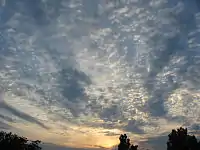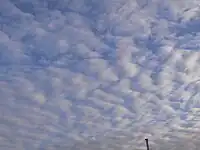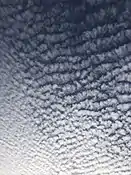| Mackerel sky | |
|---|---|
 Altocumulus mackerel sky | |
| Abbreviation | Ac |
| Symbol | |
| Genus | Alto- (mediumhigh) -cumulus (heaped) |
| Appearance | Clumps and rolls of clouds that resemble mackerel scales |
| Precipitation | No, but may signify approaching precipitation. |
A mackerel sky is a term for clouds made up of rows of cirrocumulus or altocumulus clouds displaying an undulating, rippling pattern similar in appearance to fish scales;[1][2] this is caused by high altitude atmospheric waves.[3]
Cirrocumulus appears almost exclusively with cirrus some way ahead of a warm front and is a reliable forecaster that the weather is about to change.[4] When these high clouds progressively invade the sky and the barometric pressure begins to fall, precipitation associated with the disturbance is likely about 6 to 12 hours away. A thickening and lowering of cirrocumulus into middle-étage altostratus or altocumulus is a good sign that the warm front or low front has moved closer and it may start raining within less than six hours.[5] The old rhymes "Mackerel sky, not twenty-four hours dry"[3] and "Mares' tails and mackerel scales make lofty ships to carry low sails"[6] both refer to this long-recognized phenomenon.
Other phrases in weather lore take mackerel skies as a sign of changeable weather. Examples include "Mackerel sky, mackerel sky. Never long wet and never long dry", and "A dappled sky, like a painted woman, soon changes its face".[4]
It is sometimes known as a buttermilk sky, particularly when in the early cirrocumulus stage, in reference to the clouds' "curdled" appearance.[7]
In culture
Peter Paul Rubens' A View of Het Steen in the Early Morning (c.1636) features a depiction of a mackerel sky in art.
"Ole Buttermilk Sky" by Hoagy Carmichael was nominated for an Academy Award for Best Original Song in 1946.
Gallery
 Mackerel sky over Erlangen, Germany
Mackerel sky over Erlangen, Germany
 Mackerel sky over Heidelberg, Germany
Mackerel sky over Heidelberg, Germany
 Altocumulus mackerel sky clouds over Burlington, Canada.
Altocumulus mackerel sky clouds over Burlington, Canada.
References
- ↑ Downing, L. L. (2013). Metereology of Clouds. p. 154. ISBN 9781491804339.
- ↑ Ahrens, C. Donald; Henson, Robert (2015). Metereology Today. Cengage Learning. p. 153. ISBN 9781305480629.
- 1 2 Wong, Chi-wai. "Mackerel sky, not twenty-four hours dry". Hong Kong Observatory.
- 1 2 "Ontario Regional Marine Guide". Environment Canada. Archived from the original on 2015-12-03.
- ↑ "Mackerel sky". Weather Online. Retrieved 21 November 2013.
- ↑ Lefevre, Karla (11 October 2013). "Making heads of mares' tails". NASA Earth Data.
- ↑ Klocek, Dennis (2010). Climate: Soul of the Earth. SteinerBooks. p. 32. ISBN 9781584204589.